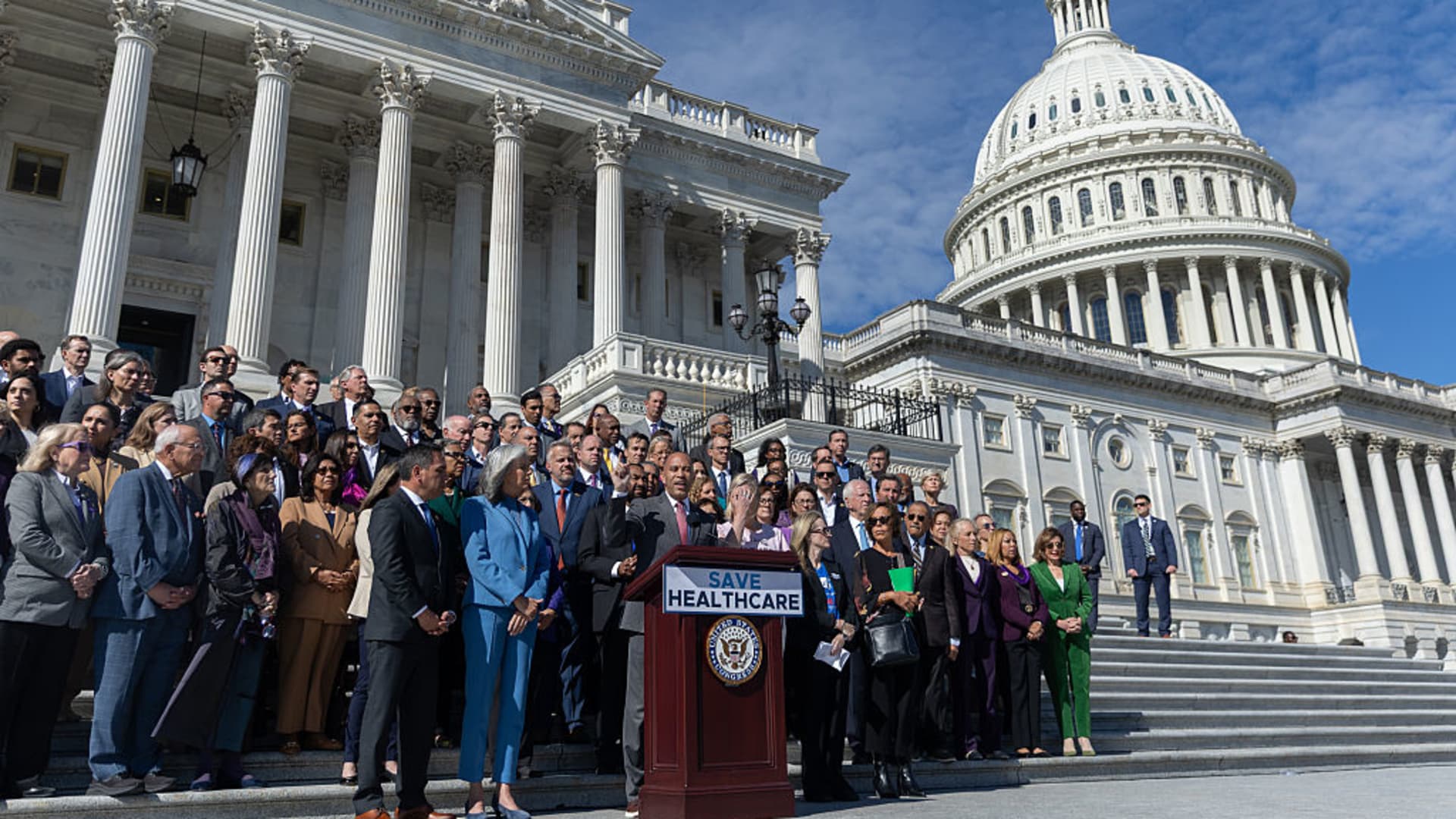House Minority Leader Hakeem Jeffries (D-NY) speaks during a press conference on healthcare with other House Democrats, on the East steps of the U.S. Capitol on the 15th day of the government shutdown in Washington, DC on October 15, 2025.
Anadolu | Anadolu | Getty Images
Americans will experience sticker shock this health insurance open enrollment season, with higher premiums for individuals and families, and for small business owners and their workers on Main Streets across the U.S., there’s little relief. While small business advocates are seeking Congressional assistance, the prospects for support are hazy, at best.
After payroll, healthcare is the biggest expense for small businesses, and increases in healthcare costs tend to hit smaller companies especially hard. As an example, family premiums for small firms have risen steadily over the past two decades. They’re up more than 350% from 1999, according to data from KFF, which was formerly known as The Kaiser Family Foundation.
To be sure, premiums are also up for large firms, but smaller companies generally feel the pinch more acutely. For firms with 10 to 199 workers, the average family premium climbed to $26,054 in 2025 from $16,977 in 2020, according to a recent KFF report.
Health care consistently ranks in the top three as the issue that “matters the most” to small business owners, according to the CNBC|SurveyMonkey Small Business Survey. Immigration and health care are in a virtual tie in the No. 2 and No. 3 positions, only topped by “jobs and the economy.”
“Any increase is challenging for small businesses because most small firms are already operating on thin margins,” John Arensmeyer, founder and chief executive of Small Business Majority, a business advocacy organization, wrote in an email.
Government shutdown and ACA tax credits
The government’s month-long shutdown doesn’t instill much confidence about lawmakers’ ability to push through major health care reform. Still, certain aspects of health care reform are under discussion, including whether to extend enhanced premium tax credits, designed to make healthcare more affordable through the Affordable Care Act (ACA) marketplace. These credits are set to expire this year.
These credits were introduced in 2021 and later extended through the end of 2025 by the Inflation Reduction Act. The enhanced tax credits boosted the level of financial assistance available to eligible ACA marketplace enrollees. Middle-income enrollees with income above 400% of federal poverty guidelines also became eligible for premium tax credits.
“Since the introduction of the enhanced premium tax credits, enrollment in the ACA marketplace has more than doubled from about 11 to over 24 million people, the vast majority of whom receive an enhanced premium tax credit,” according to KFF.
If these credits expire, many marketplace enrollees will continue to qualify for a smaller tax credit, while others will lose eligibility. These enrollees would be hit by a “double whammy,” according to KFF. They’d lose their entire tax credit and be responsible for rising premiums.
Half of all marketplace enrollees are small business owners, self-employed entrepreneurs or small business employees, according to Arensmeyer. “On the individual market, data shows that those who purchase their healthcare through the Affordable Care Act marketplace will see an average increase of 75% if the enhanced premium tax credits are not renewed,” he wrote.

A handful of deals to extend the enhanced premium tax credits have already been rejected and with the ongoing government shutdown it’s hard to say how things will shake out. Broadly speaking, Democrats would like to see the temporary cuts renewed and are concerned about the sticker shock when the credits expire, while Republicans, generally, worry about the cost — they believe they help people too high on the income scale, and claim the marketplace is rife with “fraud.”
One notable exception is Rep. Marjorie Taylor Green (R-Ga.) who has expressed frustration over the lack of a Republican alternative to the Affordable Care Act and the tax subsidy issue.
Small businesses, meanwhile, are caught in the crosswinds. A survey of 620 small business owners by Small Business for America’s Future, an advocacy group, found that 84% of respondents are concerned about their ability to afford healthcare in 2026 if the tax credits expire at year-end. According to the survey, nearly 40% said premium increases will create severe financial strain and threaten their operations. Close to a quarter said they’ll be forced to drop employee coverage.
Small businesses are lobbying Congress
Small businesses are calling on Congress to support health care reform in other ways. In October, NFIB, a nonprofit organization that advocates for small businesses, sent a letter to Congress supporting the CHOICE Arrangement Act. The bill writes health reimbursement accounts into the tax code, giving small businesses more affordable and flexible health insurance options, according to NFIB. It also provides an exemption for small businesses to allow pre-tax funds to pay for employee health care.
“The average cost of a healthcare premium for small business owners has risen over 120% since 2000,” wrote Tyler Dever, NFIB principal of federal government relations. “This significant increase has forced small businesses to make difficult choices, including limiting or eliminating health benefits to their employees. This is not an outcome small business owners desire, as it can put entrepreneurs at a disadvantage when they are competing against larger companies to fill jobs.”
The bill was referred to the House Committee on Ways and Means in September. A version of the bill has also been referred to the Senate Finance Committee.
Separately, President Trump recently suggested that Democrats and Republicans should join forces on finding an alternative to the Affordable Care Act that became law during President Obama’s administration. “We have to fix health care, because Obamacare is a disaster,” Trump told reporters on Air Force One en route to South Korea, according to a report from The Hill.
Even so, NSBA, a small business advocacy organization, doesn’t see a huge appetite for significant healthcare reform in Congress. “It’s not at the top of lawmakers’ list,” a spokesperson said.
Small business cutbacks to worker health benefits
Amid rising health-care costs, some small businesses have had to pare back. Small Business Majority’s research has found that small businesses are making some changes that include increased employee contributions to their health plans, moving to an insurance plan offering more limited coverage and cutting other employee benefits.
“The consequence is that as small businesses reduce their benefit offerings, it becomes increasingly difficult for them to compete with larger corporations for top talent,” Arensmeyer wrote. “As a result, access to quality, affordable health insurance isn’t just a cost issue for small businesses—it’s a labor issue as well.”
There’s not a lot small businesses can do to keep costs at bay, other than shop around or reconsider some of the benefits offered to workers. Still, Matthew Rae, associate director of the Program on the Health Care Marketplace at KFF, encourages small businesses to look around for potential opportunities to save. “Ask questions to your vendors and insurers to make sure you’re getting a plan that’s appropriate to your population,” he said. “You can get creative about some of the offerings so you can better manage the cost of the plans.”
GLP-1 weight loss drug pharmacy costs
Pharmacy prices are a large driver of rising costs, according to HUB International’s 2026 Benefits Cost Trend report, with high-cost prescription drugs, such as GLP-1s, a major contributor.
More than 57 million privately insured adults may qualify for GLP-1 drugs, like Ozempic, Wegovy, Zepbound and Mounjaro, according to KFF, and employer coverage of GLP-1 drugs is expanding. A notable 55% of employers cover GLP-1s for diabetes, and 36% cover them for both diabetes and weight loss, according to the International Foundation of Employee Benefit Plans.
While coverage for GLP-1 prescriptions is much more common among large employers than small businesses, recent KFF surveying of the employer market (it did not study firms with less than 200 employees) indicates that many are considering cutbacks in this coverage given the costs, despite widespread acknowledgment of the health benefits.





